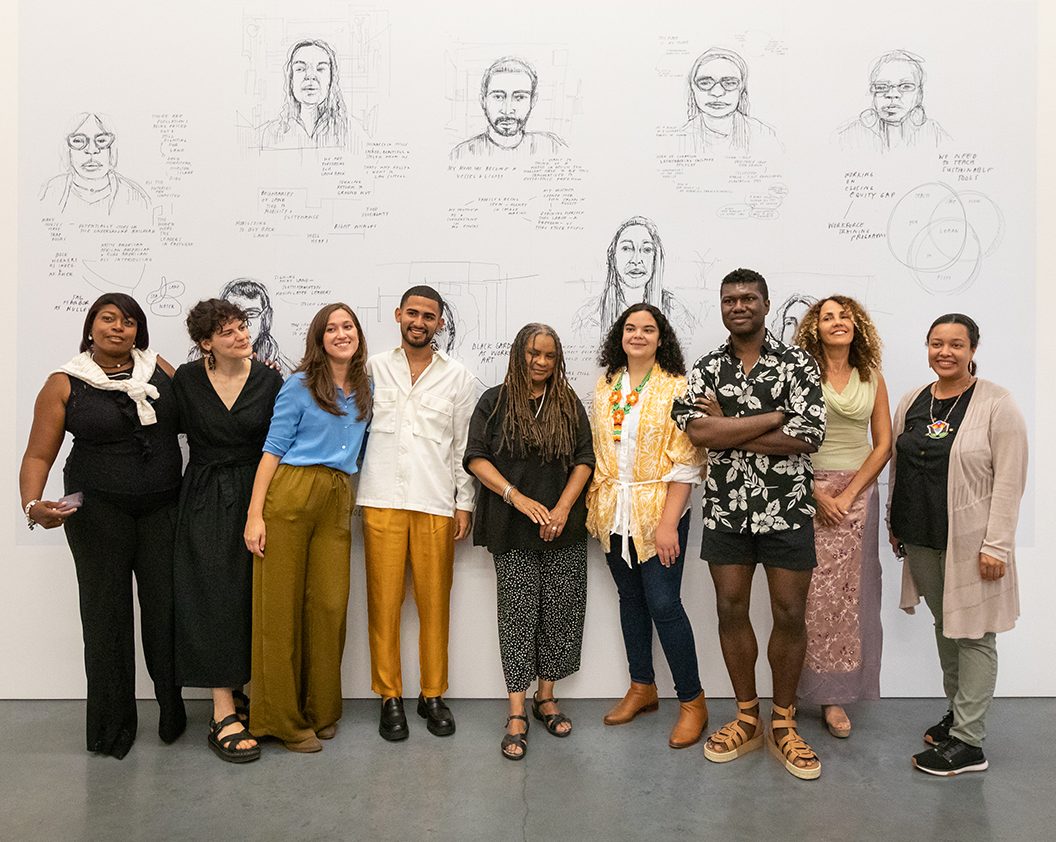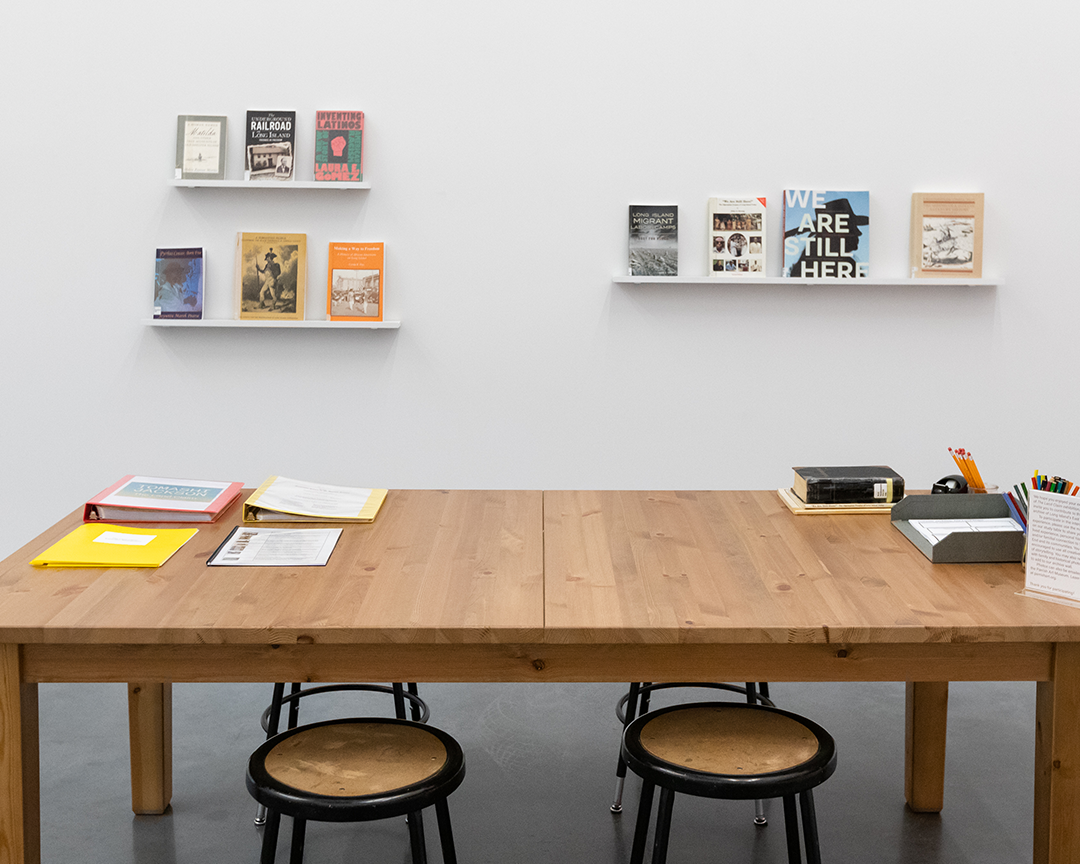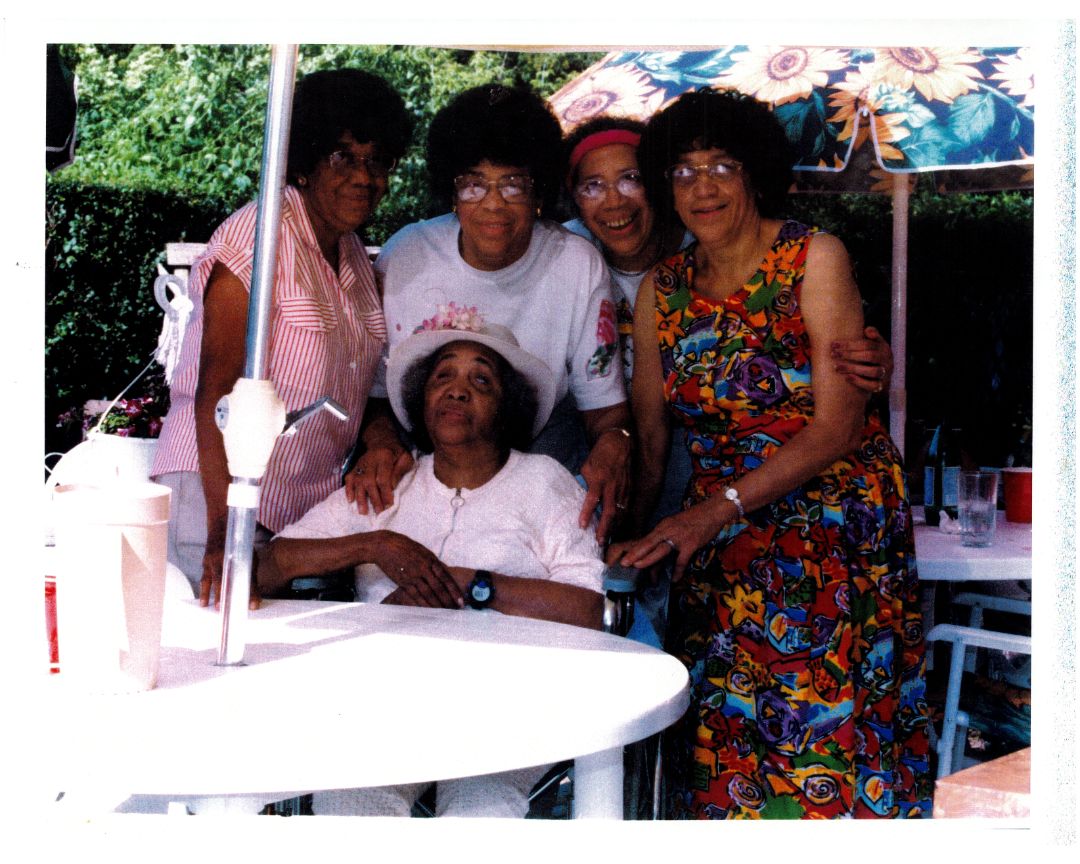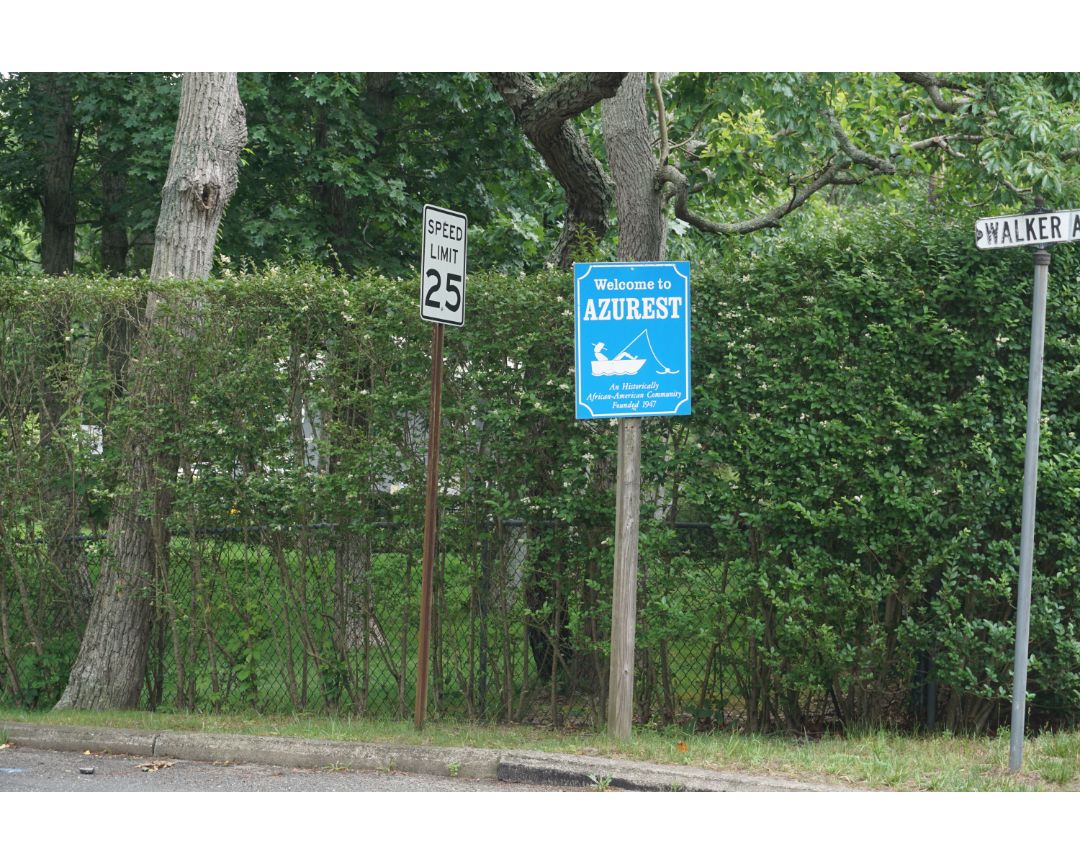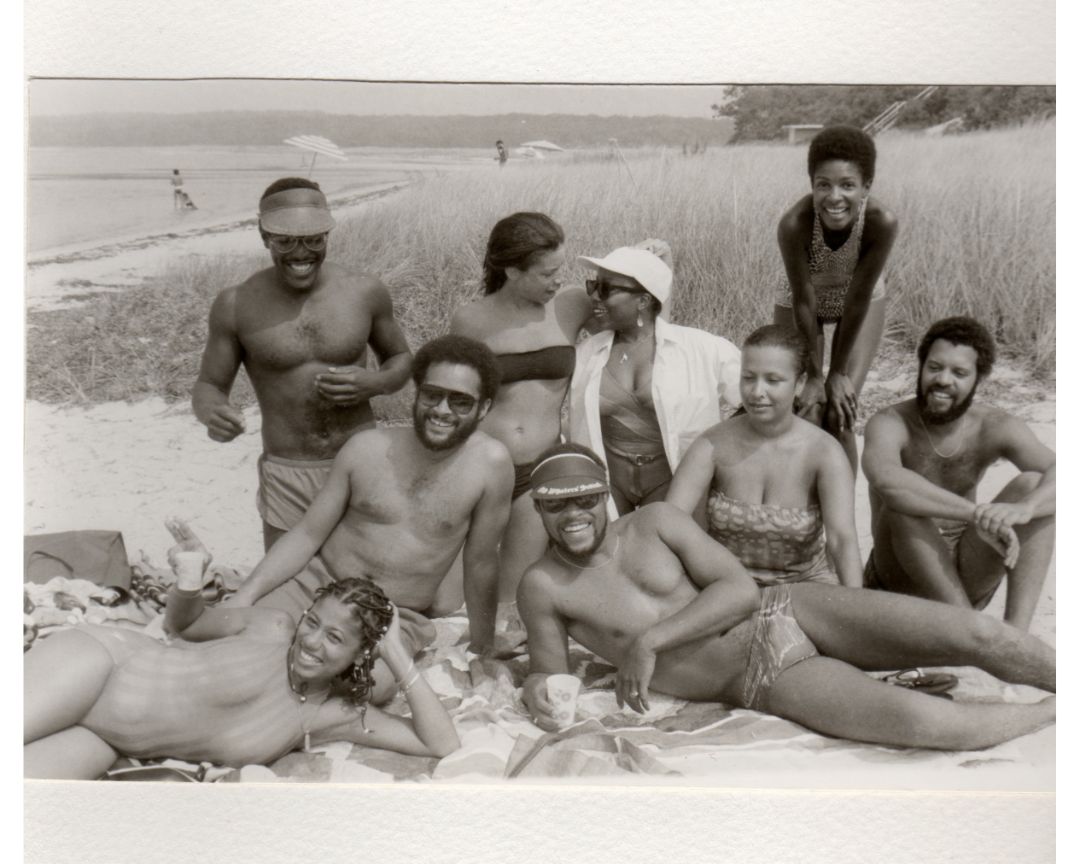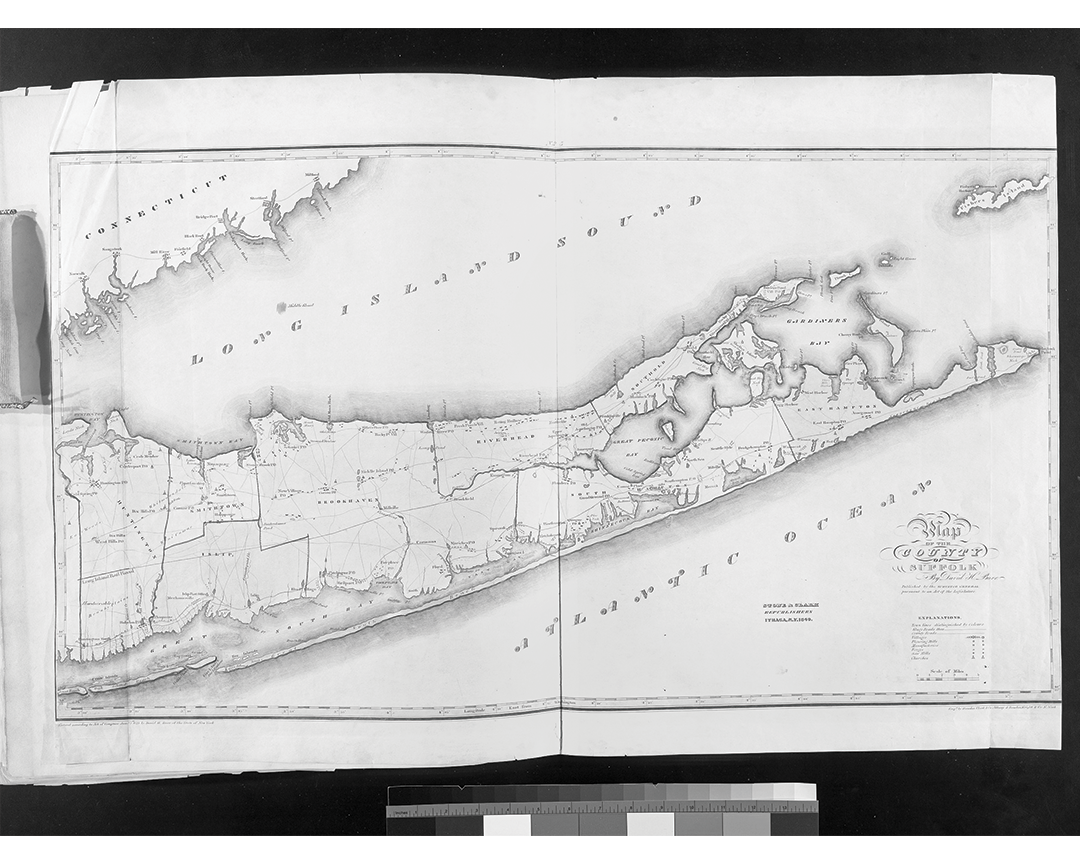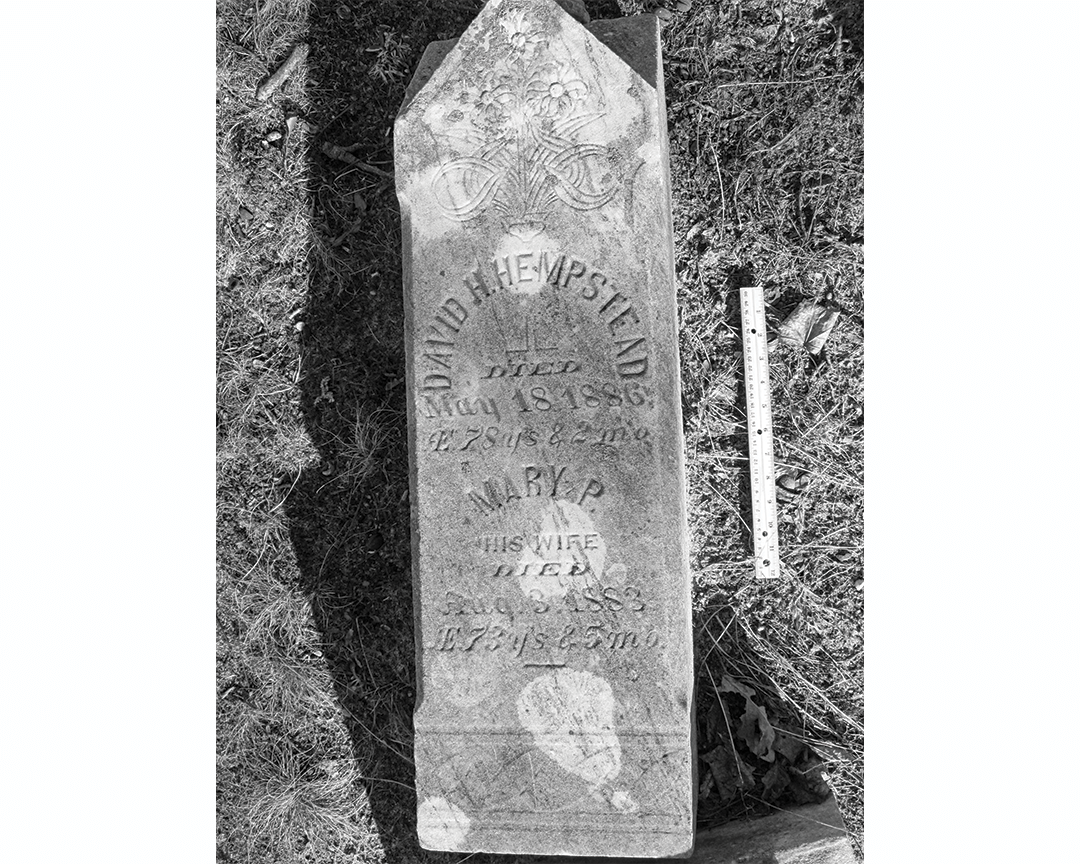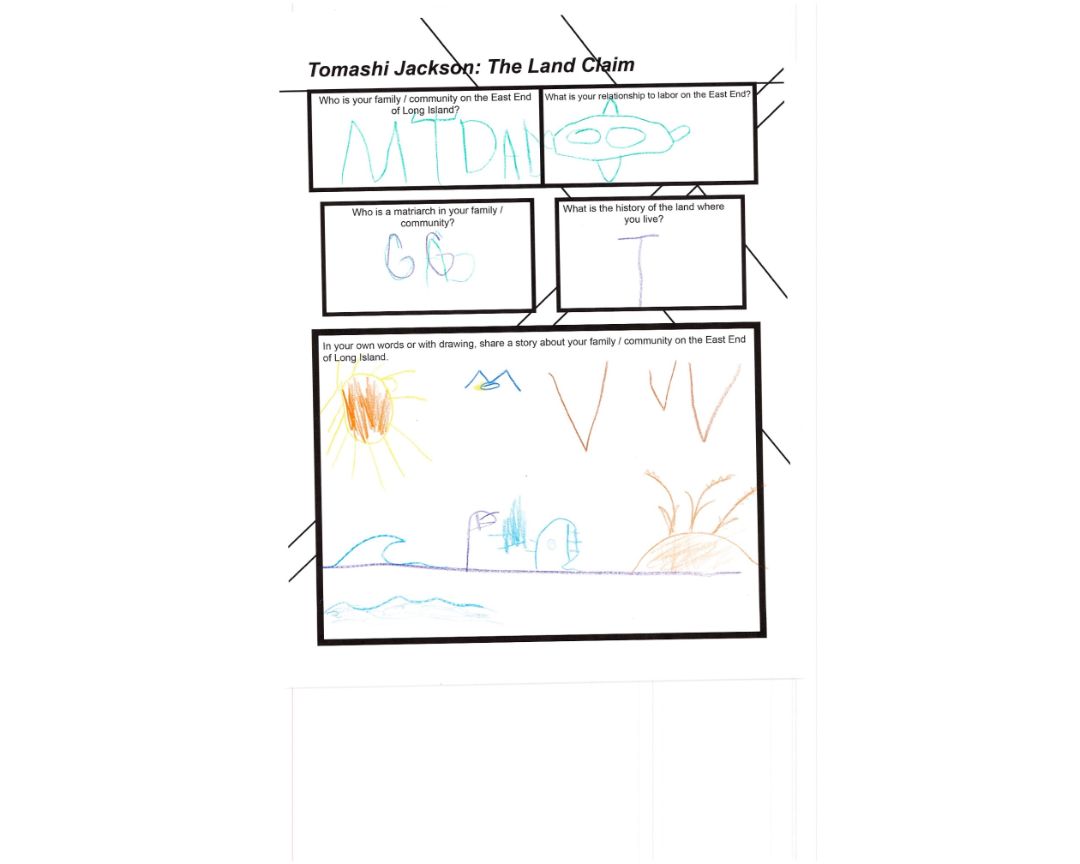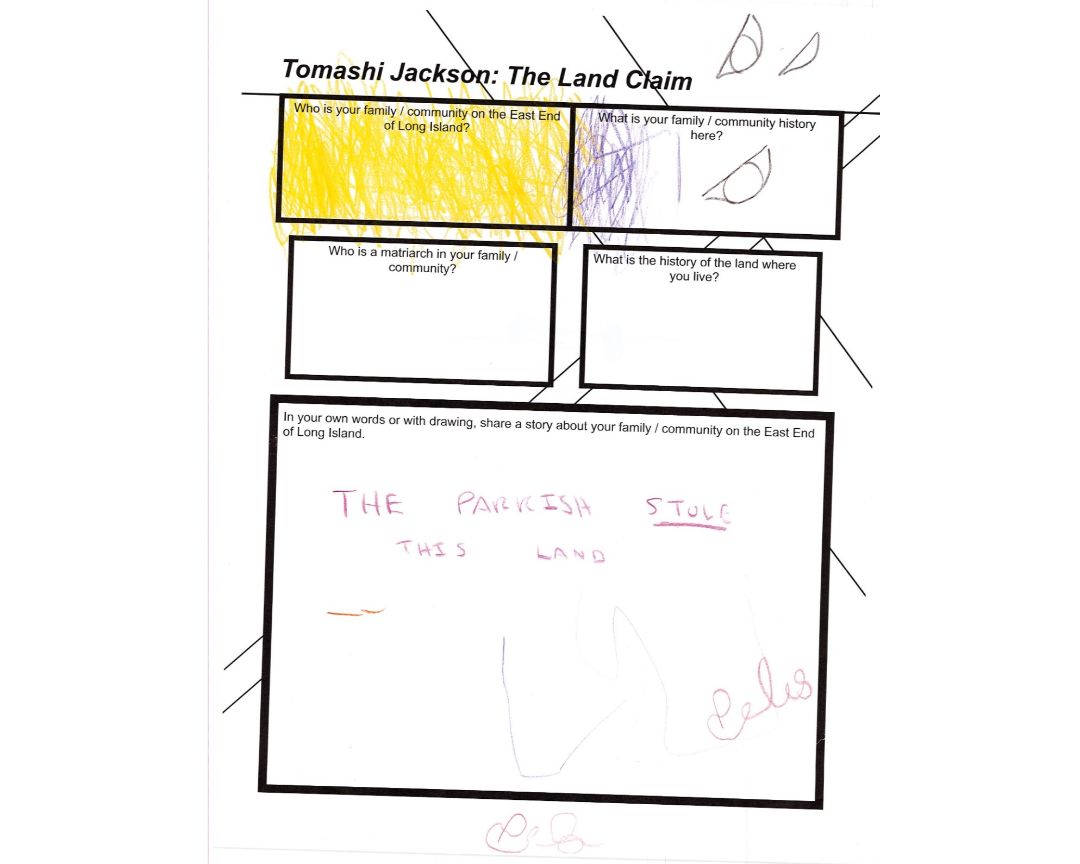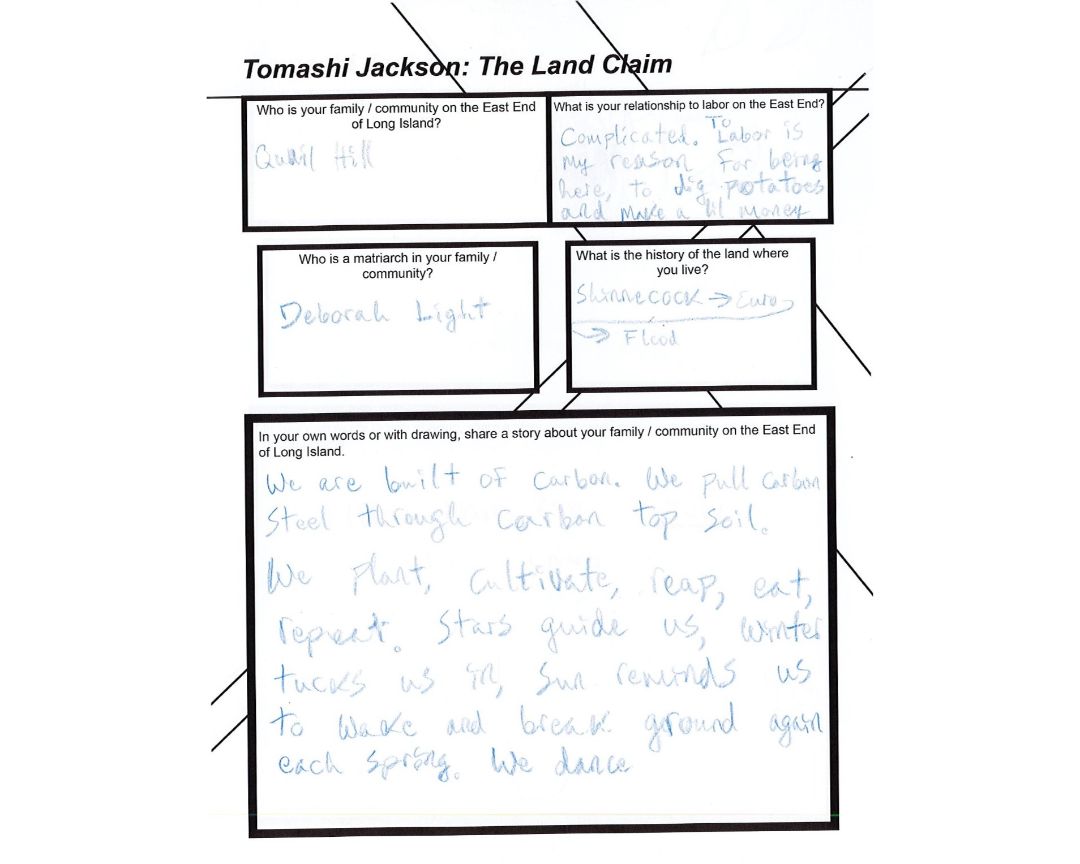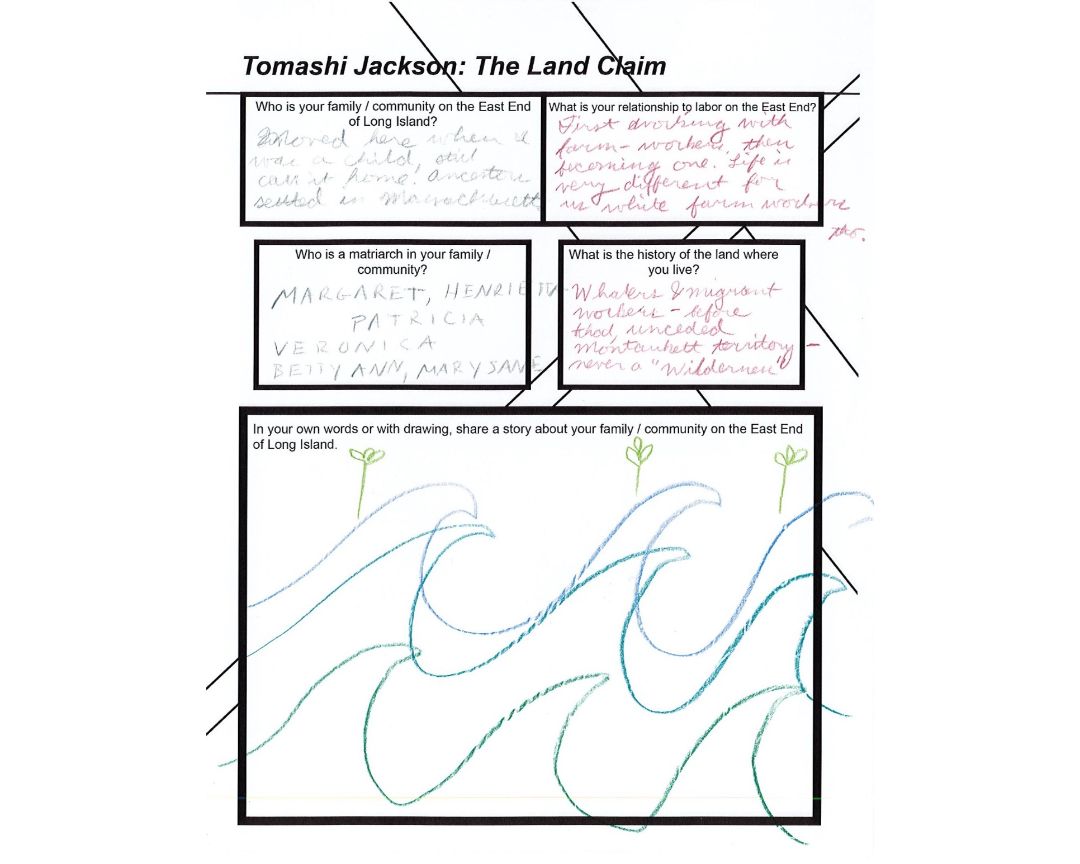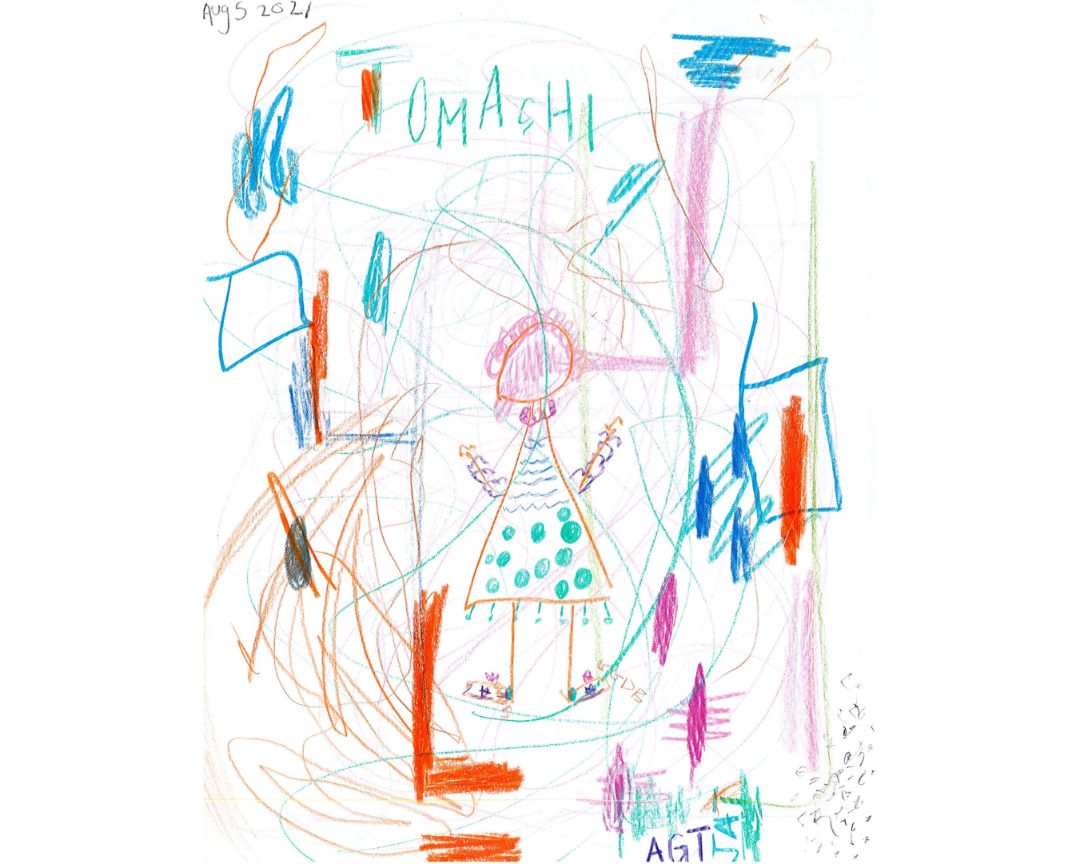Tomashi Jackson: The Land Claim
ARCHIVE
In 2020, the Parrish Art Museum invited Tomashi Jackson to create an exhibition that would consider the entire Museum as a site for works that transcend disciplinary boundaries, encouraging new ways to experience art, architecture, landscape, and community. Tomashi Jackson: The Land Claim (July 11-November 7, 2021) centered on the historic and contemporary lived experiences of Indigenous, Black, and Latinx families on the East End of Long Island and was the culmination of a 12-month research project that included oral interviews with historians and community leaders, historical images, and analysis of news articles. The exhibition opened a discourse around collective memory and historical narratives of labor, educational access, transportation, and land rights, bringing to light systemic racial segregation in the area. Jackson continued the research and created the paintings for the exhibition while in residence at The Watermill Center in spring/summer 2021 as an Inga Maren Otto Fellow, in partnership with the Parrish Art Museum.
Jackson often describes her practice as centered around meaningful generosity. In this spirit, Tomashi Jackson: The Land Claim Archive presents key elements of Jackson’s research which served as source material for a series of paintings, a publication, educational material, and a sound installation. According to the artist, each of these components make up the artwork.
THE PAINTINGS
The Three Sisters
The Three Sisters speaks to the importance of matriarchy, a common theme that surfaced during Tomashi Jackson’s conversations with members of the Shinnecock, Black, and Latinx communities of the East End. For this painting, Jackson chose to incorporate images showing intergenerational groups of women together—a tintype of two Black women and early residents from Eastville, Sag Harbor, and a picture of a Shinnecock family gathering. She collapsed their histories into one by hand-painting photographic images in halftone lines and overlaying them with images printed on transparent vinyl strips, emphasizing the interconnectedness of these communities. The Three Sisters also refers to the North American Indigenous farming intercropping method of planting corn, squash, and beans together in mounds in which each life form helps the others to grow and thrive.
Among Protectors (Hawthorne Road and the Pell Case)
Throughout her conversations with members of the Shinnecock Indian Nation, Tomashi Jackson learned about their ongoing struggle to recover stolen land. To create Among Protectors, Jackson juxtaposed news images from two events, 25 years apart, that each marked significant gains in the battle. The image from 1996, painted in blue halftone lines on the canvas, shows a member of the Shinnecock Nation sitting in the path of a truck to protect unlawful desecration of Shinnecock land. A court case in 1997 ruled that the buyer of the land, William Pell, was unlawfully intruding and the land was successfully defended. The image printed in red on the vinyl strips depicts a member of the Shinnecock Nation singing during a prayer service in 2020 at a construction site where human remains of a Shinnecock Nation member were unearthed. After months of protest, in June 2021, the Southampton Town Board voted unanimously to purchase a conservation easement through the Community Preservation Fund for 4.5 acres at the peak of Sugar Loaf Hill, the most sacred ancestral Shinnecock burial grounds. On July 20, 2021, The Peconic Land Trust closed on the parcel with the intention to preserve and return it to the Shinnecock Nation.
Among Fruits (Big Shane and the Farmer)
One theme that emerged from Tomashi Jackson’s research centered around meaningful generational experiences of labor, and how it manifested and intersected among the Shinnecock, Black, and Latinx communities of the East End. In Among Fruits (Big Shane and the Farmer), Jackson hand-painted an image of Shinnecock Nation member, artist, educator, hunter, and fisherman Shane Weeks holding a large hen of the woods mushroom that he harvested on the Reservation. The press image printed on the vinyl strips overlaying the painting depicts a Black worker in a South Fork potato field in the 1950s. Enhanced with locally sourced material—Shinnecock wampum dust, cotton textiles, and soil from a local potato field—the painting juxtaposes two opposite approaches to sourcing food: the unsustainable, and often exploitative practice of monocropping and the traditional food gathering.
IMAGE ARCHIVE
As part of the exhibition, one of the galleries was transformed into an interactive Study Room, offering an immersion into the creative process and research methodology that informed The Land Claim. It featured the archival photographs that had been generously provided by families, historical societies, libraries, and news sources—many of which are clearly visible in Jackson’s paintings.
INTERVIEWS
Beginning in January 2020, Jackson led in-depth interviews with members of Indigenous, Black, and Latinx and communities of the East End. They included Donnamarie Barnes, Director of History and Heritage at Sylvester Manor Educational Farm in Shelter Island; Bonnie Cannon, Executive Director of the Bridgehampton Child Care & Recreational Center (BHCCRC); Jeremy Dennis, a fine art photographer and Shinnecock Indian Nation member; Kelly Dennis, an attorney specializing in Federal Indian law and Secretary of the Shinnecock Council of Trustees; Dr. Georgette Grier-Key, Executive Director and Chief Curator of the Eastville Community Historical Society; Minerva Perez, Executive Director of OLA (Organización Latino-Americana) of Eastern Long Island; Tela Loretta Troge, an attorney and counselor at law; and Richard “Juni” Wingfield, a long-time community liaison for the Southampton School District.
Throughout the process, Jackson worked with artist and educator Martha Schnee and research scholar K. Anthony Jones to transcribe and analyze the interviews. Schnee also drew portraits and notes during the interview sessions. All images are reproductions of original ink on vellum drawings and notes by Martha Schnee (American, born 1993) from The Land Claim interviews, 2021.
TOURS & PROGRAMS
PANEL | Reflections from The Land Claim
TALK | Tomashi Jackson, Corinne Erni, & Minerva Perez
TOUR | Spanish-Language Exhibition Tour
TALK | Tomashi Jackson, Corinne Erni, K Sue Park, & Kelly Dennis
ARTICLES
Directly tied to the images and oral histories shared by the interviewees are the archival materials from written news sources documenting their intergenerational collective memory. These articles preserve the many accounts of sacred land protections, agricultural labor, educational access, transportation, and land rights experienced by local communities of color.
‘Dark days’ at the Cutchogue labor camp
September 26, 2014 | Paul Squire, The Suffolk Times | PDF
Immigrants Share Fears Of National Policies, ICE Raids
Febuary 20, 2017 | Amanda Bernocco, The Southhampton Press | PDF
Suffolk and Nassau Law Enforcement Policy of Detaining Immigrants on ICE Warrants Ruled Illegal
November 14, 2018 | Patrick Young, Esq., Long Island Wins | PDF
Why a Hamptons Highway Is a Battleground Over Native American Rights
May 27, 2019 | Corey Kilgannon, New York Times | PDF
Shinnecock Protest Building On Ancient Burial Grounds
January 14, 2020 | Dan’s Papers | PDF
In Plain Sight, a Long-Buried History of East Hampton’s Enslaved
February 6, 2020 | David E. Rattray, The East Hampton Star | PDF
Black LI Family On ‘Subtle’ Racism: It’s Not Just The N-Word
July 15, 2020 | Lisa Finn, The Patch | PDF
Telling their stories: Research highlights the role of enslaved people on LI
August 21, 2020 | Multiple Contributors, Newsday | PDF
On Long Island, a Beachfront Haven for Black Families
October 1, 2020 | Sandra E. Garcia, New York Times | PDF
Native Americans Have Been Taking on Billionaires in the Hamptons
November 26, 2020 | Walker Bragman & Mark Colangelo, Jacobin Magazine | PDF
SUPREME COURT PETITION
Tomashi Jackson titled the exhibition The Land Claim after a conversation with a member of the Shinnecock Indian Nation, Kelly Dennis, who brought her to understand that the story of the Hamptons is inextricably connected to land appropriation. This Supreme Court Petition, co-written by Dennis, was filed in 2016 is a prime example of contemporary land rights activism taking place on the East End. Scroll and click through the PDF to read the full document.
READING LIST
Additional reading related to the histories and identities represented in Tomashi Jackson: The Land Claim were available in the Study Room for visitors to learn more about the topics featured in Jackson’s work.
Bancroft, Dick, and Laura Waterman Wittstock. We Are Still Here: A Photographic History of the American Indian Movement. Minnesota historical Society Press, 2013.
Day, Lynda Rose. Making a Way to Freedom: A History of African Americans on Long Island. Empire State Books, 1997.
Gomez Laura E. Inventing Latinos: A New Story of American Racism. The New Press, 2020.
Hayes, Katherine Howlett. Slavery before Race: Europeans, Africans, and Indians at Long Island’s Sylvester Manor Plantation, 1651-1821. New York University Press, 2013.
Marcus, Grania Bolton. A Forgotten People: Discovering the Black Experience in Suffolk County. Society for the Preservation of Long Island Antiquities, 1988.
Pearse, Joysetta Marsh. Pyrrhus Consor, Born Free. TAAGS, 2014.
Stone, Gaynell. The Shinnecock Indians: a Culture History. Suffolk County Archaeological Association, 1983.
Torres, Mark. Long Island Migrant Labor Camps: Dust for Blood. The History Press, 2021.
Velsor, Kathleen G. The Underground Railroad on Long Island Friends in Freedom. The @History Press, 2013.
Wortis, Helen. A Woman Named Matilda, and Other True Accounts of Old Shelter Island. Shelter Island Historical Society, 1978.
COMMUNITY CONTRIBUTIONS
While exploring the exhibition, visitors were invited to contribute their own family stories and experiences to an Interactive Wall through drawings and written responses.
They became yet another collection of the many histories on the East End.

Tomashi Jackson in her studio at The Watermill Center, June 2021. Photo: Copyright Jessica Dalene, courtesy of The Watermill Center.
ABOUT TOMASHI JACKSON
Tomashi Jackson (born 1980, Houston, TX) is a multidisciplinary artist working across painting, textiles, sculpture, and video to place formal and material investigations in dialogue with recent histories of displacement and disenfranchisement of people of color, resulting in formalist compositions of exuberant color, bold geometries, and intricate layerings of material. She was invited as part of the Parrish Art Museum’s 2021 annual invitation to an artist to consider the entire Museum as a site for works that transcend disciplinary boundaries, encouraging new ways to experience art, architecture, landscape, and community.
Learn more about Tomashi Jackson at Tilton Gallery.
Tomashi Jackson: The Land Claim was organized by Corinne Erni, Senior Curator of ArtsReach and Special Projects, with research assistance by Curatorial Fellow Lauren Ruiz.
Tomashi Jackson: The Land Claim was made possible thanks to the generous support of The Andy Warhol Foundation for the Visual Arts; National Endowment for the Arts; The Bandier Family Foundation; The Mr. and Mrs. Raymond J. Horowitz Fund for Publications; The Dorothy Lichtenstein ArtsReach Fund, established by Agnes Gund; Connie Tilton; The Lumpkin-Boccuzzi Family; The Deborah Buck Foundation; Miyoung Lee and Neil Simpkins; Sandy and Stephen Perlbinder; The Speyer Family Foundation, and Nina Yankowitz.
We are also grateful to Night Gallery, Los Angeles and Tilton Gallery, New York, for their in-kind support.
We are pleased to partner with The Watermill Center in support of Tomashi Jackson’s project and acknowledge their generous partnership through their Inga Maren Otto Fellowship.
Additional support for the Archive was provided by Cara Conklin-Wingfield, Education Director; Brianna Lynn Hernández Baurichter, Curatorial Fellow; Maria Elizabeth, Education Fellow; and Alexandra Paul Zotov, Digital Communications Manager.




